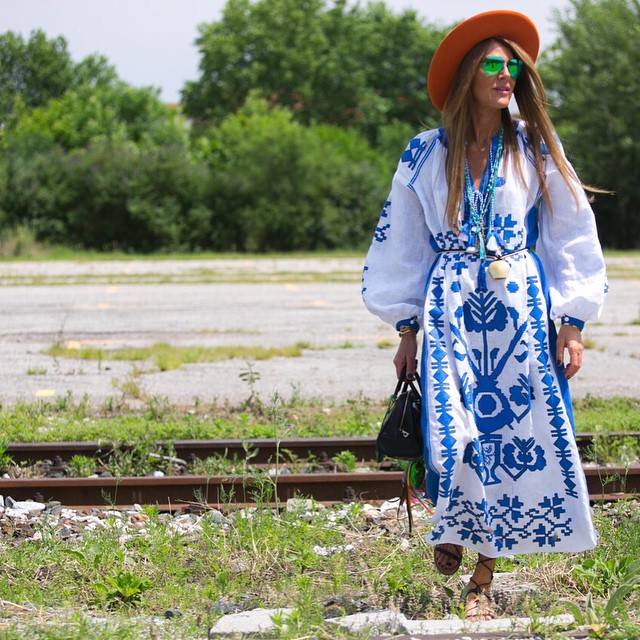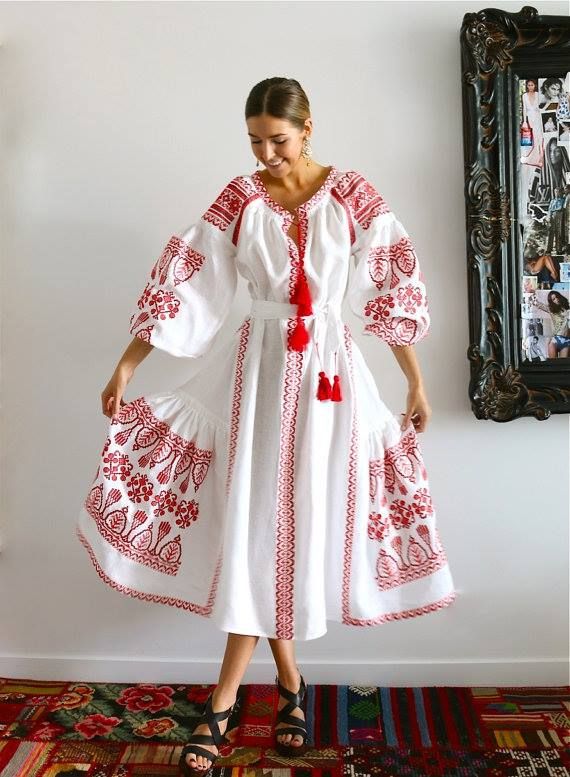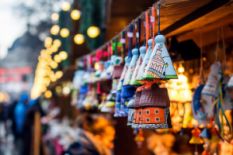Vyshyvanka is a traditional in Ukraine embroidered garb, which is the most essential part of the national costume. These days vyshyvanka is gaining international fans like Anna Dello Russo and Joan Osbourne, who simply rocked the vyshyvanka- look throughout Fashion Week in 2016.
It seems like Ukrainian ethnic motives became a big hit in world fashion. The big guys of the fashion world have started to discover Ukrainian costume and have brought it on to the top catwalks of Europe and US. The hype was probably started by designer Frida Giannini, who made an Autumn/Winter 2008-09 ready-to-wear collection for Gucci with recognizable Ukrainian folk costume elements. And after a runway at Valentino spring 2015 couture, Ukrainian traditional costume has knowingly and unknowingly penetrated fashion for years. In addition to groovy boho embroidered peasant blouses and red geometric patterns on puffy sleeves of linen garbs, models were wearing traditional for Ukraine braid and floral crowns.

Photo: International fashion icon Anna Dello Russo in vyshyvanka by Ukrainian designer Vita Kin
The sudden appreciation of Ukrainian traditional dress on an international level can be credited to the major rise of patriotism in Ukraine during the Euromaydan and the Revolution of Dignity. Traditional Ukrainian style became trendy. One day a group of Ukrainian students decided to organize a flash-mob wearing their long-forgotten vyshyvanka to classes and BOOM, suddenly this initiative caught such a hype that a year later this day was simply turned into National Vyshyvanka Day in Ukraine.
Interesting fact, the first fashionable dresser who combined vyshyvanka with workaday clothes was Ivan Franko. He wore it under his jacket and together with modern garments. The writer appears on 20-Hryvnia note dressed exactly like that. From the capital of Kyiv to the patriotic city of Lviv, the vyshyvanka is the staple uniform for women, men, and children, who support traditional and modern incarnations of the sartorial piece of history. It looks like people are genuinely happy to be able to turn vyshyvanka into a fashionable street style and wear it far more regularly than on religious holidays when they attend church.
Traditionally vyshyvanka has a very strong spiritual power. The patterns of embroidery are very symbolic. There are guardian embroidery, patterns that tell a specific story about the owner of the shirt, adornments that bring luck and so on. All the authentic adornments are strong omens and tokens which were aimed to guard the owners of the embroidered dress or shirt from bad energy. Usually white cloth is embroidered with red and black threads, but there are also some variations: white embroidery on white cloth, black on white, red on black, blue on white and colorful (red, black, yellow, green, orange, blue etc.) patterns.
The variety of the Ukrainian traditional embroidery patterns is characterized by wide regional and ethnic diversity. The patterns of embroidery are different for different regions of the country. Among the most popular styles are the following ones: Hutsul, Lemkiv and Rusyn. Close proximity to other cultures and ethnic groups (Hungarians, Poles, Gypsies etc) resulted in the multiformity of the Ukrainian traditional vyshyvanka styles.
The traditional Ukrainian garb has passed a long way with some of the elements remaining intact since the times of ancient Slavs. Vyshyvanka was once a long linen shirt (both for men and women) decorated with embroidered floral or geometry ornament with a woven waistband. Embroidery is the major adornment of the traditional Ukrainian costume. Special decorative fabrics and different ribbons and threads of beads add festivity to garments.
 Vogue, the iconic fashion magazine, has recently named the Ukrainian Vyshyvanka the hottest trend of the season. Hence, the Ukrainian influence has fully arrived in our closets and Ukrainian ethnic motives are the trendiest thing you can add to your summer wardrobe.
Vogue, the iconic fashion magazine, has recently named the Ukrainian Vyshyvanka the hottest trend of the season. Hence, the Ukrainian influence has fully arrived in our closets and Ukrainian ethnic motives are the trendiest thing you can add to your summer wardrobe.
Photo source: Vita Kin official instagram account, elle.ua, pinterest.com. All images belong to their rightful owners.







